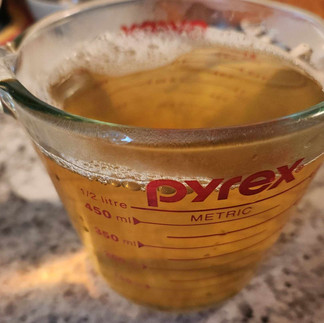
I usually make 2 batches at a time so you will see some double photos showing both my batches using chickpeas and soybeans. I used Koji rice for both batches this time although I usually make one with Koji rice and one with Koji barley.
INGREDIENTS:
454 GRAMS (1 LB) ORGANIC BEANS
454 grams (1 LB) KOJI RICE OR KOJI BARLEY
Vinegar or Lemon Juice (for soaking beans)
190 GRAMS REAL SALT OR FINE SEA SALT (140 grams in the recipe, 50 grams sprinkled on top)
1/4 TO 1 CUP BEAN WATER
MISO paste is a delicious addition to our diet and we love adding it to soups, rice, fish, vegetables, casseroles and is a wonderful savory addition to just about anything you can think of. Traditional Miso is made with soybeans. We also use chickpeas or a combination of the two and we’ve even used white beans mixed with chickpeas.
Soybeans originated in the Orient and were originally used as a cover crop to fix nitrogen and later only eaten fermented as they contain substances that are harmful if not processed properly. Soy must be fermented as this will neutralize all of the anti-nutrients, making it a healthy and delicious food. Our society promotes this legume as a good alternative to meat or dairy products, especially as tofu, not mentioning to the public that it is not good for us at all unless fermented. It actually inhibits protein digestion, blocks the uptake of key minerals, encourages clot formation, stunts growth in the young and has been found to be cancer causing. It also causes severe digestive upset in most people. The great thing is that if it is fermented, it turns into a high protein, healthy, tasty food. A great article to read for more information is The Ploy of Soy located on the Weston A. Price Foundation website. Miso involves a two step fermentation process. First, a mold such as Aspergillus oryzae is inoculated onto a substance like rice, barley, rye or soybeans and allowed to ferment. Then when added to the bean mash with salt, it ferments with bacteria and yeast to make the unique taste and valuable nutrition of miso. It is fermented for several months and up to several years. White miso has a larger percentage of koji rice and is only fermented a short time. Red miso has a higher proportion of beans to rice and is fermented longer. The darkest brown/black miso is fermented for an extended period of time, potentially 5 or 10 years. The longest we’ve done is 2 years and it was rich, dark and delicious. The savory salty taste is called umami and this revs up our digestion process, improves our gut microbiome and is high in vitamins and minerals. The diversity of our microbiome provides many benefits including to strengthen the immune system, better digest our food to extract more nutrients and has even been found to improve our physiological wellbeing. The rich number of isoflavones in the soy that are made easily available are naturally and gently antimicrobial, anti-inflammatory and even fight cancer, which as you can see is the opposite that happens when we eat unfermented soy.
We ferment our soybean miso at least 1 year and our chickpea miso over 6 months because we like the flavor of the longer ferment. There are some who like it as early as 3 to 4 months. You can taste it along the way and see what you prefer. Warmer temps will speed up the process, cold will slow it down. It is actually better to let it age in a cooler environment. We put it in a dark closet and let it sit. Some say to stir in the liquid that will collect on the top. This is called tamari and is a good for you form of soy sauce. Commercially made soy sauce is not normally fermented, full of sodium chloride and is not good for you like tamari is. We do not bother our miso, don't ever stir it and either pour off the tamari, soak it up with a towel if only a small amount or just leave it, as it seals the top and keeps the mold from growing. I think it would be difficult to stir it in and not get air into the product.
Chances are that mold will grow on top of your miso. If it is white or green, it is fine and it can be scraped off. If we get any, it usually appears around the edges. I do my first check at the 2 week mark, then again after 3-4 months, then maybe 6 months later, then at 1 year and either jar it in pint or half pint jars then or let it go longer. I will replace my silicone disc when I check it in the later months if it has any mold at all. It is too hard to clean and the discs are inexpensive enough to just put a new one on each time. I will also use a towel soaked in a bit of 100 proof vodka to wipe any mold off the sides of the crocks or to do any clean up needed. I haven’t ever got much mold as I am super careful when I put it in the crock, I use gloves when I do anything with it and I wipe with alcohol, replacing baggies and saran wrap every time. You will learn as you go what works for you. Be patient as the process will be worth every minute.
EQUIPMENT:
LARGE BOWL (to soak beans and later to mix everything)
SMALL BOWLS (for the salt-140 grams in one, 50 grams in another)
FOOD PROCESSOR OR BOWL AND POTATO MASHER
SPATULA
LARGE COLANDER
1 CUP-MEASURING CUP
FOOD PREP GLOVES
CROCK OR OLD CROCKPOT INSERT OR ANY OTHER CONTAINER THAT IS CERAMIC OR GLASS (Not metal, plastic or wood)
SILICONE SHEET or ROUND-Cut in a circle the same size as the inside of the crock. Some people use plastic wrap here but I won’t use soft plastic wrap on any food, especially on something fermenting as I believe it would leach into the food. I order the silicone lids for bowls online and cut them to size. I have several on hand, as I may need to change it when I check the miso if there is mold on it.
SCISSORS
UTILITY KNIFE
PLASTIC WRAP
CARDBOARD CIRCLE-Cut the same size as the crock. You will put this into a
ZIPLOCK PLASTIC BAGS (gallon size). The cardboard circle with the plastic bag on the outside will sit on top of the silicone circle that is sitting on the miso. You will also use a plastic bag to put your ceramic weight in if using.
WEIGHTS (CAN USE CERAMIC CROCK WEIGHTS, GLASS FERMENTATION WEIGHTS, BALL BEARINGS IN A BAG OR PLASTIC CONTAINER, BAG OF BEANS, ETC. The weights should be at least 5 pounds and preferably the same weight as the miso in the crock. I use the ceramic weights and a plastic container that holds ball bearings and a few glass fermentation weights because this is what I have handy.
COVER OR LID-can use a towel, lid or plate or anything that covers the top and keeps dust and debris out. I use a tea towel tied around the crock with a string.
PREP: Clean all your equipment really well. You don’t want any other microbes competing with the Koji. I wash everything and rinse really well, then wipe everything down with 100 proof alcohol, especially inside the crocks and the silicone circle that sits right on top of the miso. I also wipe my food processor parts, and pour boiling water in my bowls, putting in the spoons and measuring cups to clean as well. Just make sure everything is as clean as you can. Allow crock to dry well before adding your miso.
1. Measure & Rinse your beans. Soybeans will be soapy when you rinse them so rinse until the water is clear. Soak beans overnight, around 14-16 hours. Add 2 TBS vinegar or lemon juice per cup of beans to soaking water and mix well. The above is 1 pound per bowl, about 3 cups.
2. The next day, rinse your beans really well in a colander, put into a pot and bring to boil on the stove. When it comes to just before boil, there will be foam on top. Pour this liquid off using the colander set in sink, rinse the beans well with running water and put beans back in pot again with new fresh water. Repeat, strain and rinse. I do this twice for all beans, 3 times for soybeans. Save at least a cup of the bean water to use when you mash the beans.
3. While heating the beans, Measure the salt-40 grams into small bowl, 140 grams into larger bowl.
4. In the large bowl, mix the Koji rice or barley with the salt and set aside.
5. After the last rinse, let the beans cool some and put into food processor or bowl to hand mash. If you like chunky miso, hand mashing is fine and a potato masher works well. I prefer it smooth and use the food processor. Add a little of the bean water to the beans in the processor or bowl before mashing. Do not add much. Add a little more as needed, just enough to make sure the beans are ground smooth. You do not want it too wet. Use the minimal amount you need to get a smooth paste. I used about ¾ cup this time but have used more or less at other times. You don’t want to overdo the water as this is what can increase your chance to grow mold.
6. Mix the smooshed beans with the Koji rice and salt. Use your hands (wearing gloves) to mix it all really well.
7. Form a ball of the mixture about the size of a small orange in your hand making sure there are no air bubbles in it. Gently but firmly toss it into the bottom of the crock so it “splats” against the crock. Do this over and over, occasionally pushing down on the miso to make sure there are no air bubbles. If there are, mold can grow so NO AIR BUBBLES!
8. When all mixture is in the crock, smooth the top with your gloved fingers.
9. Wipe the sides of the crock above the paste with an alcohol moistened towel to get all miso off that might have splattered on it. Wipe the rim and the top outside to make sure it is all clean.
10. Sprinkle the other 50 grams of salt you have waiting in the little dish all over the top of the bean mixture being careful to get a good amount around the sides.

11. Put your silicone ring you have cut and ready on top of the paste and press it firmly but gently down all over.
12. Tear off a piece of plastic wrap bigger than your crock and press it down over your silicone ring making sure you seal all around the edges so you cannot see any paste and the wrap is folded or smooshed around the edges.
13. Put your pre-cut cardboard circle into the ziplock bag, seal and place on plastic wrap which is on top of the silicone ring, folding up sides into middle.
14. Place weights on top of this. I put my ceramic weight on first and also put it in a plastic bag so tamari does not get on it (the ceramic weight pictured below does not have the plastic bag on it yet). I then put my plastic container with ball bearings inside on top of that.
15. Cover with lid or towel and tie on.

16. Check after about 1-2 weeks to see if everything looks ok and to see if there is an excess of liquid on top. You can soak this up, pour it off or leave it alone. I usually pour it off or soak it up at this point.
17. Place container in cool, dark place for 4-6 months or additional months or years as you desire.
NOTE: I check it every few months. I taste it as I go and stop when it gets to the flavor I like, always fermenting soybeans at least a year or more. I check to see if I need to change out the silicone circle. There may be a bit of mold on the circle or the side of the miso. I’ve only had a little in these places. I use an alcohol-cleaned and dried spoon to scrape anything off, or wipe it off the side of the crock with a alcohol moistened paper towel. If the silicone has some on it and it is too hard to clean off, I replace that. If there is any liquid on the top, I usually pour it off or soak it up with a towel. I don’t usually have much of this as I don’t put much liquid into my miso when I make it. Some recipes say to mix it back in, but I don’t like to disturb my miso that much and don’t do that. As the miso ages, it will become more rich and robust flavored.
If it ever has a funky or bad smell, gets wet sink holes or large amounts of mold or has mold particularly on the inside because of air, it will need to be thrown away. I have not had this happen but want to make sure you don't eat anything that is contaminated or spoiled. Small amounts of mold on the top edges is normal, large amounts are not.
Once your miso gets to the flavor and age you like, you can transfer into smaller jars. I use half pint or pint canning jars. Make sure they are sterile and dry before spooning or using a spatula to transfer from crock to jar. Avoid too many air bubbles. I spoon some in, press down, spoon some more, press down, etc. Put lid the on tight. Refrigeration will slow or stop the fermenting process and your paste will now be preserved. Remember to label with details about the kind of bean, Koji and date. Always use a clean utensil to remove your miso from the jar to not contaminate it. It should last several years in refrigeration.
I hope this blesses you. Kena


"But the fruit of the Spirit is love, joy, peace, patience, kindness, goodness, faithfulness, gentleness, and self-control…" Gal 5:22-23
All information is for informational and educational purposes only and are not intended or implied to diagnose, treat, cure, prevent, prescribe for or remark on any disease or medical state.






























































Comentarios